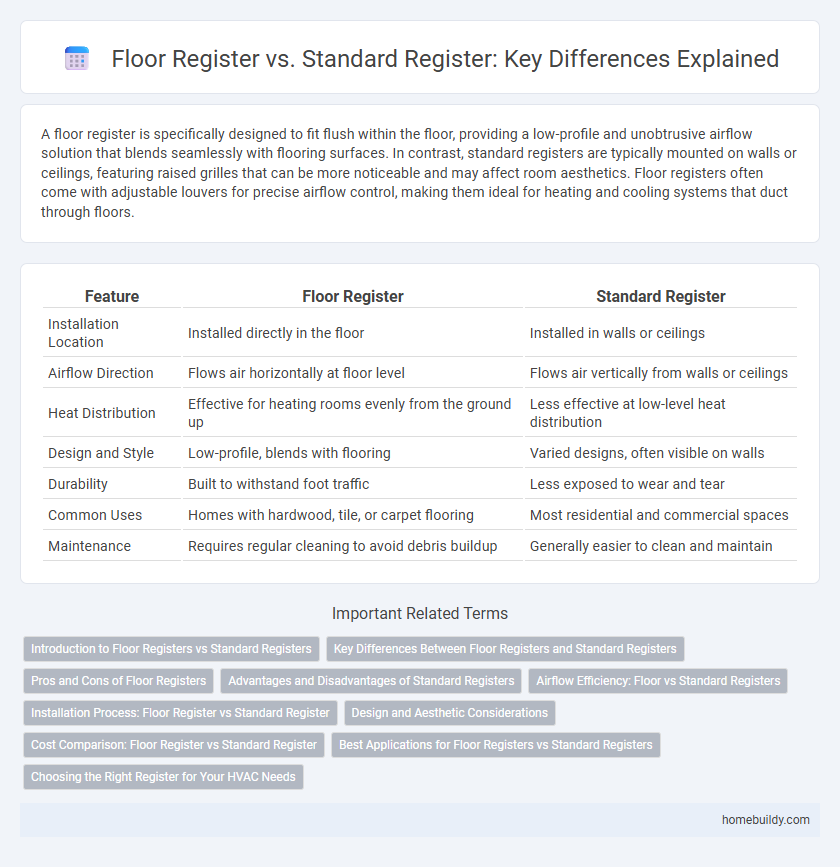A floor register is specifically designed to fit flush within the floor, providing a low-profile and unobtrusive airflow solution that blends seamlessly with flooring surfaces. In contrast, standard registers are typically mounted on walls or ceilings, featuring raised grilles that can be more noticeable and may affect room aesthetics. Floor registers often come with adjustable louvers for precise airflow control, making them ideal for heating and cooling systems that duct through floors.
Table of Comparison
| Feature | Floor Register | Standard Register |
|---|---|---|
| Installation Location | Installed directly in the floor | Installed in walls or ceilings |
| Airflow Direction | Flows air horizontally at floor level | Flows air vertically from walls or ceilings |
| Heat Distribution | Effective for heating rooms evenly from the ground up | Less effective at low-level heat distribution |
| Design and Style | Low-profile, blends with flooring | Varied designs, often visible on walls |
| Durability | Built to withstand foot traffic | Less exposed to wear and tear |
| Common Uses | Homes with hardwood, tile, or carpet flooring | Most residential and commercial spaces |
| Maintenance | Requires regular cleaning to avoid debris buildup | Generally easier to clean and maintain |
Introduction to Floor Registers vs Standard Registers
Floor registers are designed to fit flush with the floor, providing a discrete and durable ventilation solution compared to standard wall or ceiling registers. These registers are specifically engineered to withstand foot traffic and integrate seamlessly into flooring materials like hardwood, tile, or carpet. Standard registers, typically mounted on walls or ceilings, offer easier access for adjustment but lack the durability and low-profile design essential for floor installations.
Key Differences Between Floor Registers and Standard Registers
Floor registers differ from standard registers primarily in their placement and design, as they are installed directly in the floor, allowing air to flow upward, while standard registers are typically mounted on walls or ceilings for horizontal or downward airflow. Floor registers often feature a sturdier construction to withstand foot traffic and may include adjustable dampers for precise airflow control. The choice between floor and standard registers impacts heating and cooling efficiency, aesthetic integration, and maintenance requirements within HVAC systems.
Pros and Cons of Floor Registers
Floor registers offer superior air distribution in rooms where wall or ceiling placement is limited, ensuring efficient heating or cooling at floor level. They can be more prone to dirt accumulation and damage due to foot traffic, requiring frequent cleaning and durable materials to maintain performance. Unlike standard wall or ceiling registers, floor registers may slightly reduce floor space and face challenges with carpets or furniture placement but excel in directing airflow precisely where occupants need it most.
Advantages and Disadvantages of Standard Registers
Standard registers offer easy installation and compatibility with most HVAC systems, providing reliable airflow control in various room settings. However, they may lack the durability and design flexibility found in floor registers, leading to possible air leakage and reduced aesthetic appeal. Maintenance can be simpler, but their fixed positioning may limit optimal air distribution compared to floor-mounted options.
Airflow Efficiency: Floor vs Standard Registers
Floor registers generally offer higher airflow efficiency compared to standard wall or ceiling registers due to their strategic placement near the floor where cooler air naturally collects, enhancing air circulation throughout the room. Their design minimizes obstruction and allows for better heat exchange, contributing to consistent temperature regulation and energy savings. Standard registers may face airflow restrictions from furniture placement or wall interruptions, reducing overall ventilation performance.
Installation Process: Floor Register vs Standard Register
The installation process of a floor register typically requires cutting a precise opening in the floor and securing the register to prevent movement, while a standard register is often installed in wall or ceiling vents with clips or screws designed for those surfaces. Floor registers must align flush with the flooring to avoid tripping hazards and ensure efficient airflow, whereas standard registers generally snap into frames or mount directly to duct openings. Proper sealing and placement are critical in both types to maintain HVAC system efficiency and air distribution.
Design and Aesthetic Considerations
Floor registers feature low-profile grilles that blend seamlessly with hardwood or tile flooring, offering a more discreet ventilation solution compared to standard wall or ceiling registers. Their designs often include decorative brass or bronze finishes, enhancing room aesthetics while maintaining airflow efficiency. Standard registers tend to prioritize function over form, with bulkier frames that may disrupt interior design flow.
Cost Comparison: Floor Register vs Standard Register
Floor registers typically cost more than standard wall or ceiling registers due to their robust design and materials required to withstand foot traffic. Installation of floor registers often incurs higher labor costs because it involves cutting into flooring and precise fitting, unlike standard registers which are easier and quicker to install in walls or ceilings. Long-term maintenance expenses for floor registers can also be higher due to wear and tear, increasing their total cost of ownership compared to standard registers.
Best Applications for Floor Registers vs Standard Registers
Floor registers excel in high-traffic areas and large open spaces where discreet airflow is essential, offering durability and preventing damage from foot traffic. Standard registers are best suited for wall or ceiling installations, enabling efficient directional airflow control in smaller rooms or hallways. Choosing floor registers enhances ventilation in living rooms or basements, while standard registers optimize airflow in bedrooms and offices.
Choosing the Right Register for Your HVAC Needs
Floor registers offer superior airflow control and heat distribution compared to standard registers, making them ideal for rooms with low-mounted duct openings. Their adjustable louvers allow precise direction of air, enhancing HVAC efficiency and comfort. Selecting a floor register over a standard one depends on duct placement, room layout, and desired airflow patterns for optimal temperature regulation.
Floor register vs standard register Infographic

 homebuildy.com
homebuildy.com